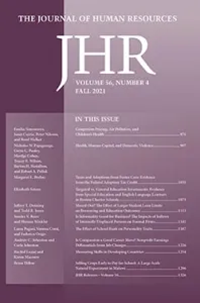劳动力市场中的垄断
IF 6
1区 经济学
Q1 ECONOMICS
Journal of Human Resources
Pub Date : 2022-03-21
DOI:10.3368/jhr.monopsony.special-issue-2022-introduction
引用次数: 143
摘要
企业在工资设定方面拥有一定市场力量的想法在经济学中很难被接受。事实上,直到最近,教科书还将垄断权力视为一种理论上的安全主义,或者一种过去仅限于少数公司城镇的概念。在理论创新、实证研究结果、戏剧性的法律案例和新的数据集的推动下,这种观点一直在迅速变化,这些数据集使以不同方式衡量市场力量的程度成为可能。对EconLit数据库的搜索显示,提及“垄断”的期刊文章数量从20世纪80年代的两篇增加到20世纪90年代的20篇、21世纪初的32篇和2010年代的64篇。本卷包含一套11篇论文,最初是在我们三人(Ashenfelter、Farber和Ransom)组织的圣丹斯劳动力市场垄断会议上发表的。这些论文共同为劳动力市场中市场力量的研究现状提供了丰富的视角。其中四篇论文使用Manning(2003)提出的框架来估计个体企业劳动力供应的弹性。一篇相关论文研究了城市之间的流动摩擦。另外三篇论文以产业组织的“结构-行为-绩效”范式为基础,将特定工人群体的工资水平与当地集中度的衡量标准联系起来本文章由计算机程序翻译,如有差异,请以英文原文为准。
Monopsony in the Labor Market
The idea that firms have some market power in wage-setting has been slow to gain acceptance in economics. Indeed, until relatively recently, the textbooks viewed monopsony power as either a theoretical curiosum, or a concept limited to a handful of company towns in the past. This view has been changing rapidly, driven by a combination of theoretical innovations, empirical findings, dramatic legal cases, and new data sets that make it possible to measure the degree of market power in different ways. A search of the EconLit database shows that the number of published journal articles mentioning “monopsony” rose from only two in the 1980s to 20 in the 1990s, 32 in the 2000s, and to 64 in the 2010s. This volume contains a set of 11 papers originally presented at the Sundance Conference onMonopsony in LaborMarkets, organized by three of us (Ashenfelter, Farber and Ransom). Together the papers offer a rich perspective on the current state of research on market power in the labor market. Four of the papers use the framework pioneered by Manning (2003) to estimate the elasticity of labor supply to individual firms. A related paper looks at mobility frictions between cities. Three other papers, building on the “structure–conduct–performance” paradigm of industrial organization, relate the level of wages for specific subgroups of workers to measures of the local concentration
求助全文
通过发布文献求助,成功后即可免费获取论文全文。
去求助
来源期刊

Journal of Human Resources
Multiple-
CiteScore
7.00
自引率
1.90%
发文量
53
期刊介绍:
The Journal of Human Resources is among the leading journals in empirical microeconomics. Intended for scholars, policy makers, and practitioners, each issue examines research in a variety of fields including labor economics, development economics, health economics, and the economics of education, discrimination, and retirement. Founded in 1965, the Journal of Human Resources features articles that make scientific contributions in research relevant to public policy practitioners.
 求助内容:
求助内容: 应助结果提醒方式:
应助结果提醒方式:


